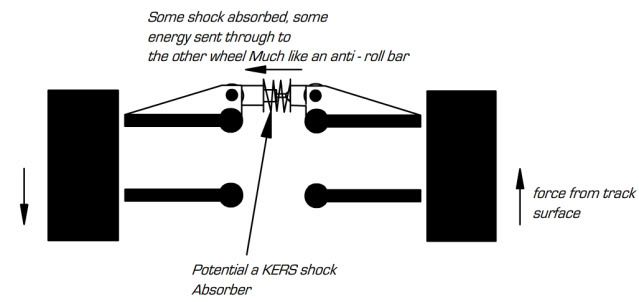Now before I start explaining this thought I feel I ought to mention I've done very little with suspension, and I am about to read competition car suspension.
So here's the concept..



This is what I thought you were going for, green. Figured this was for an electric vehicle.Ciro Pabón wrote: I remember that maybe 10 or 15 years ago they did something (with a linear generator instead of a hydraulic shock absorber) at Tufts University: it was suited to charge electric vehicles, so I guess it's a winner with you.


Ok, Ok, we got it. There you go, I found the post I made, that includes a crude estimate of the energy you can get from a regenerative front suspension (trying to guess how much a shock absorber would heat in a race). Enjoy, and criticize, if you're so kind:greenpower dude reloaded wrote:... But really the question is, Is the set up I have there, in principle, likely to be effective enough in circuit racing?
...
I apologize for quoting myself. Conclusion: you get around 250 watts. Please, take in a account that a road where your fanny moves up and down only 2 mm per meter is a extremely smooth road (a new one). If the road is bumpier, you'll get more energy, of course. A very rough road (dirt road, full of potholes) can give you an IRI of 12 to 15 tops (mm per meter, that is).Sure, a damper or shock absorber (SA for short) is like a resistor. In all types of SA, energy is absorbed by friction forces and converted into heat. These friction forces are proportional to the velocity of friction elements.
That heat surely goes into the liquid or gas that is inside the SA, minus what it radiates. The amount of radiation, judging by the form factor most SA have, does not seem to be the main concern of the designer (no SA with cooling fins are popular, AFAIK).
F1 SA, I imagine, must generate low heat, compared with a normal damper. First, the "resistance" is limited, because the friction forces are limited, because the amplitude of movement is limited, because:
1. F1 cars have "hard" suspensions
2. F1 cars ride low
Second, the "current" you have, or load of the SA, is smaller than in a normal car:
3. F1 cars weigh less than most cars
Anyway, let's put some rough numbers to it, following a long tradition of amateurs in this site...
The IRI (I've mentioned it before, it's the International Roughness Index) tells you how many millimeters moves up and down the body of a car when it moves through 1 meter of road. I repost the IRI model car, Mikey_s knows it better than me, I'll say only that Ms is the body mass, Mus is the suspension's and that xs is the movement of the body:
IRI model of a "quarter-car": just one wheel with one spring and one shock absorber
I suppose F1 tracks have an IRI of, let's say 2 mm/m (it could be 3, maybe, but I do not want to open the calculator, so I'll round a lot from now on).
Take in account this "quarter car" used as reference has springs, weights and SA that are different from the ones an F1 car has, which means more "travel" of the body.
Anyway, let's imagine a car on a track of 5 km with 75 laps. Without calculator I round that to 400 km. The car must move up and down 800 m through the entire race (at 2 mm per meter of track).
Of course, this is the "throughtput" of energy through the resistor, not the energy damped (on the contrary, it represents the energy NOT damped, but let's assume they are of the same order of magnitude). With a gravity of 10 m/s2 I get:
Energy = m*g*h = 600 kg * 10 m/s2 * 800 m = 5 Mjoules
If the race takes 1.5 hours, which is like 5.000 seconds, give or take, you have:
Power = 5.000.000 Joules / 5.000 seconds = 1 Kwatt
This is more like 500 watts if you take in account that half of the energy (at least, if no more) goes to the rear shock absorbers.
Now, there are other things, beside SA, that adsorb energy, that is, wheels and springs, shown on the posted picture as "kt" and "ks". Let's assume that wheels and springs dissipate only half of the energy, even if that's probably conservative for an F1 car, famous for relying on wheels to provide shock absorbing power.
We arrive to a power around 250 watts, which is like three light bulbs. That's enough to keep your legs a tad warmer than my taste. Anyway, part of this heat surely can be managed by simple cooling systems.
As far as I remember, there have been posted in this site some pictures showing air vents on top of the frontal part of the cockpit, surely for cooling. I suppose the energy of the body inside a fire suit is larger than the numbers I got.
Surely I must have made some mistakes, I appreciate if somebody has the time or the interest to point them out.